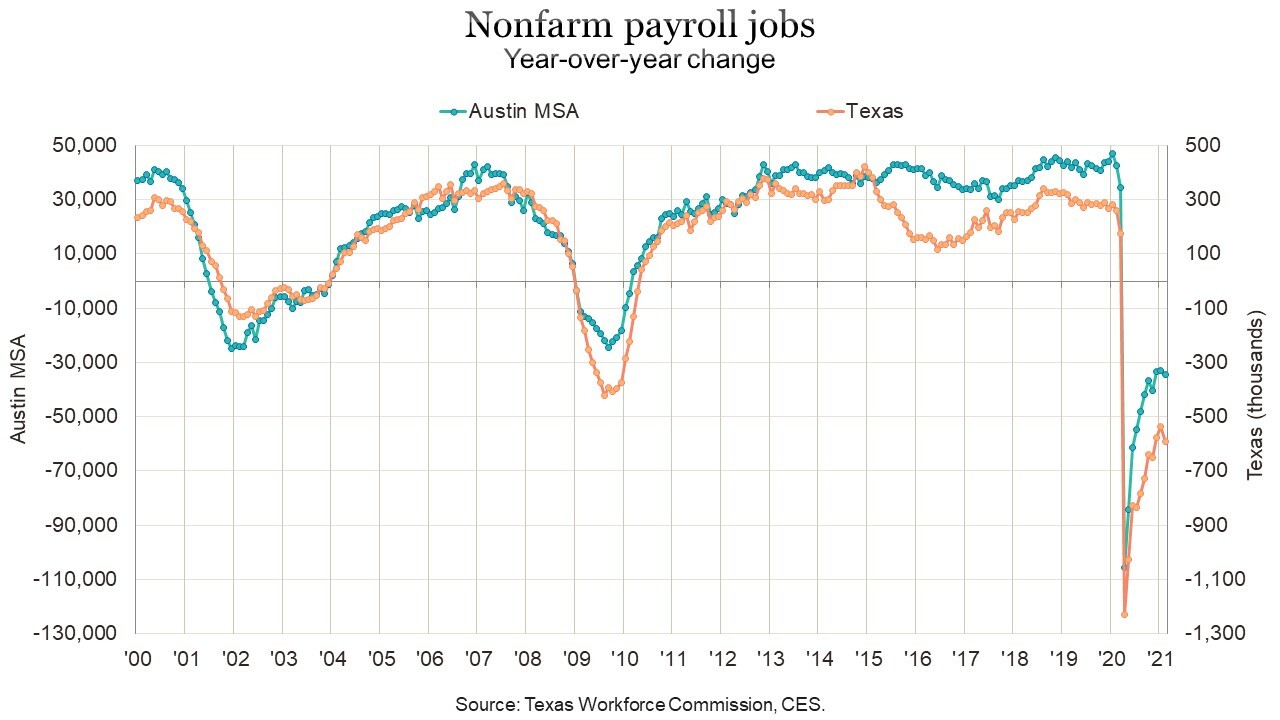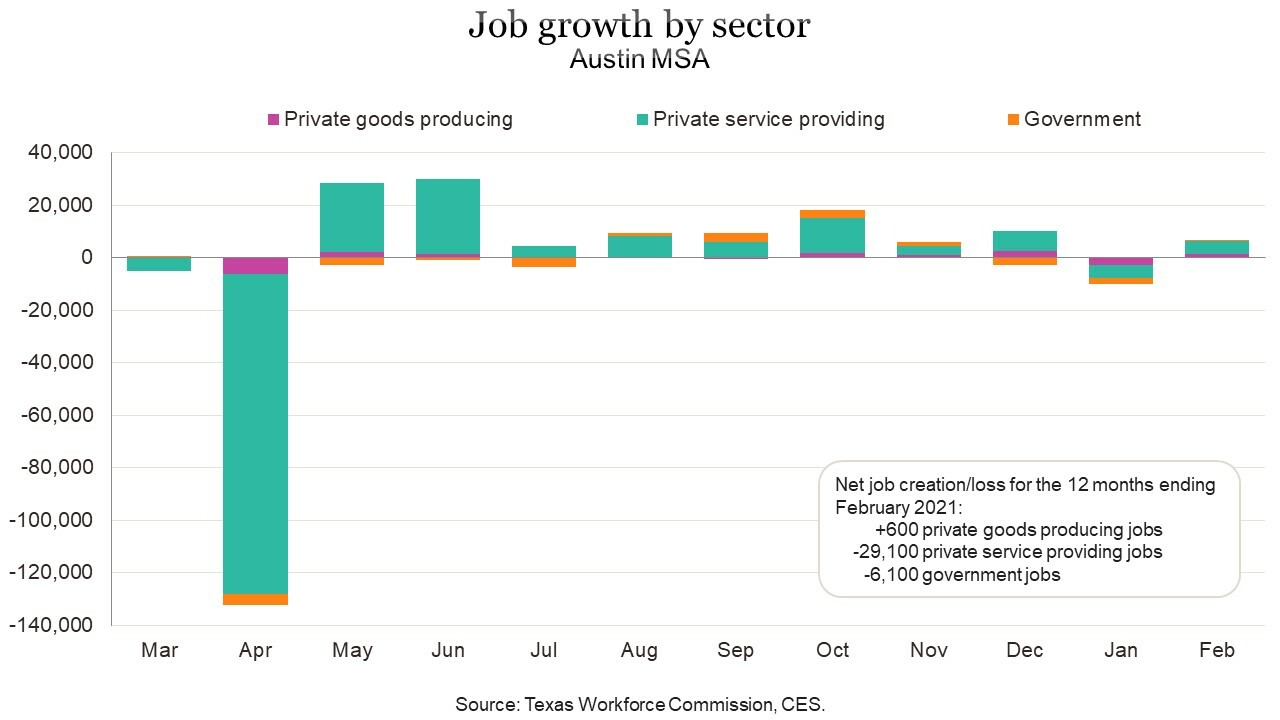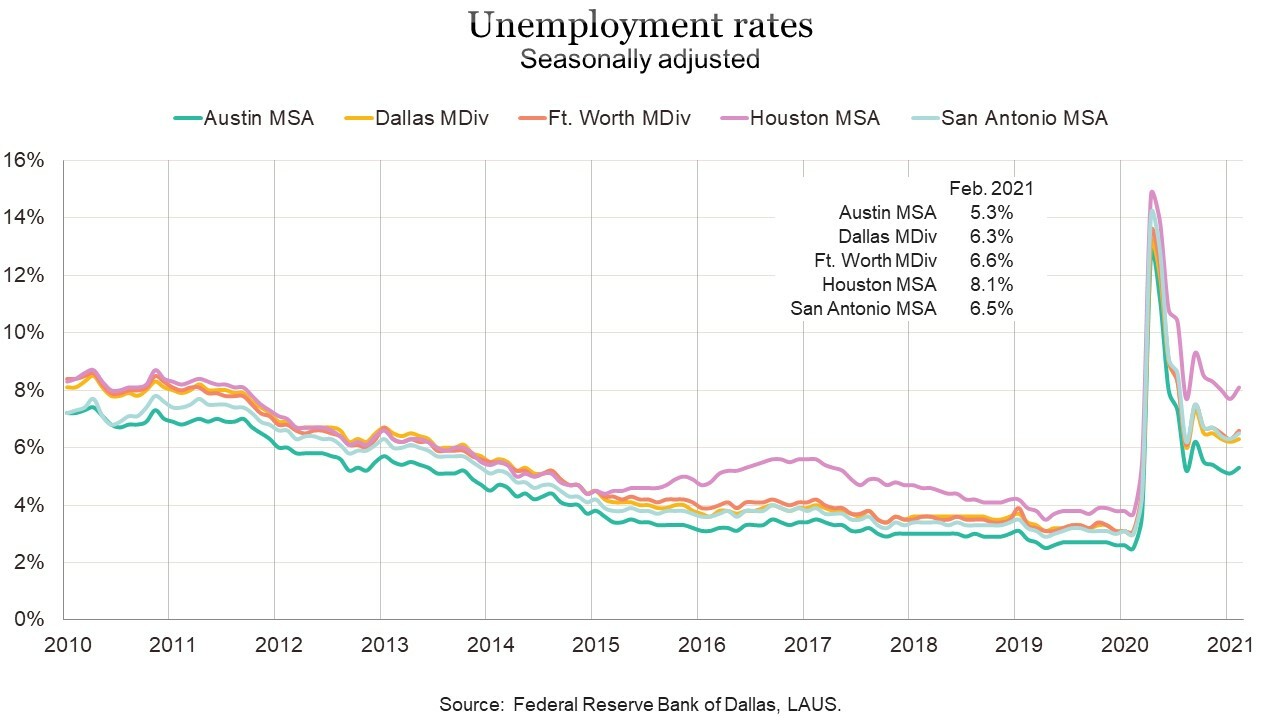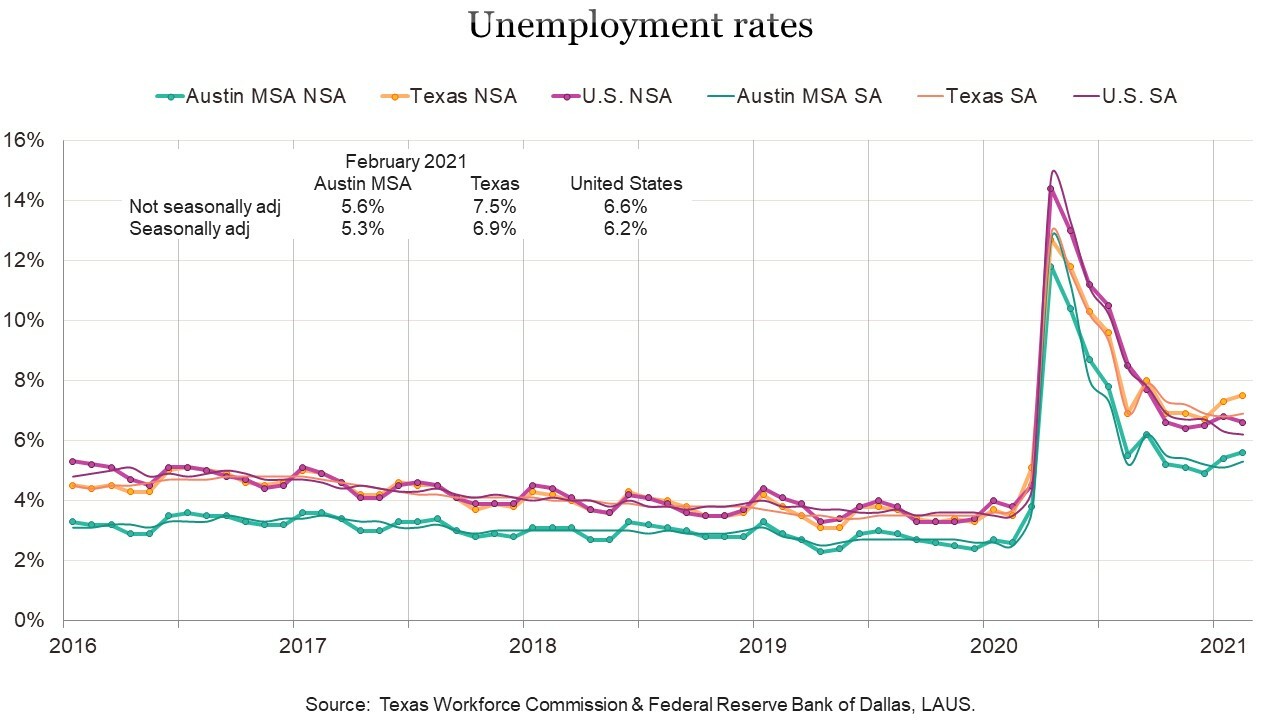Job growth & unemployment
Sign up for the Central Texas Economy Report newsletter
For opportunities with Austin employers currently hiring, see the Chamber's Austin Job Opportunities page.
Posted on 03/30/2021 by Beverly Kerr
- Adding jobs in nine of the last 10 months, Austin has regained 75% of last spring’s pandemic-related job losses.
- Austin’s 3.0% year-over-year job loss is more moderate than the declines seen in all but two other major metros.
- Although growth was negative each of the last three months, Austin’s leisure and hospitality industry has seen 52% of the 61,500 jobs lost in March and April of 2020 return.
- Austin's seasonally adjusted unemployment rate increased from 5.1% in January to 5.3% in February.
Nonfarm payroll jobs
The Austin metropolitan area added 6,700 jobs in February, gaining back most of the 9,900 jobs shed in January, according to Friday's releases of preliminary Current Employment Statistics (CES) payroll jobs numbers by the Texas Workforce Commission (TWC) and the U.S. Bureau of Labor Statistics (BLS).

Austin’s nonfarm payroll jobs total as of February is 1,107,800. One year ago, before the impacts from COVID-19, Austin had an estimated 1,142,400 jobs. Combining job losses for March and April, Austin lost 137,000 jobs, or 12.0%. Positive growth in nine of the last 10 months has brought back 102,400, or 75%, of those jobs.

Austin’s year-over-year decline of 3.0%, or 34,600 jobs, makes it the third best performing among the 50 largest metro areas. Dallas and San Antonio also ranked in the top 10. Fort Worth’s loss of 4.5% ranks 12th and Houston’s 6.8% deficit ranks 29th. Four major metros—Las Vegas, San Francisco, Orlando, and Los Angeles—remain down by more than 12% compared to February 2020.
For the year ending in February, private sector job loss in the Austin MSA is 3.0%, or 28,500 jobs, with losses occurring in five of the 11 major private industry sectors. Total job losses were also 3.0% because Austin's sizable government sector (17% of jobs) shrank by a similar magnitude—3.2% or 6,100 jobs.

Texas saw net private sector job losses of 5.0% with all but one private industry sector losing jobs over the last 12 months. Total job losses were 4.6% as the government sector, which accounts for 15% of total state employment, had slighter losses (2.4%). For the nation, private sector losses were 6.0% for the 12 months ending in February with all private industries losing jobs. Overall job loss was also 6.0% as government sector’s losses were comparable (5.9%).

Jobs in February are up by 6,700 jobs or 0.6% from January in the not-seasonally-adjusted series for Austin. In the seasonally adjusted series, jobs increased by 700 or 0.1%. Seasonally adjusted jobs are up by 0.2% in San Antonio and essentially unchanged in Houston. Dallas and Fort Worth jobs fell by 0.3% and 1.0% respectively. Statewide, seasonally adjusted jobs are down 27,500 or 0.2%. Nationally, seasonally adjusted jobs are up from January by 379,000 or 0.3%.

In Austin, six private industry sectors have positive growth over the last 12 months, most notably transportation and warehousing (13.5% or 3,300 jobs), wholesale trade (3.5% or 1,900), and professional and business services (2.9% or 5,800).
The greatest number of job losses, and greatest percent change, over the last year happened in leisure and hospitality (21.8% or 29,300 jobs). Other services saw a 9.1% decline (4,300 jobs) and education and health services is also notably down (5.7% or 7,600).

Additional graph – New/lost jobs by industry: Jan.-Feb. 2021
Leisure and hospitality shed 61,500 jobs in March and April of last year (45% of all jobs lost). With positive growth in six of the last 10 months, the industry has regained 32,200 of those jobs (31% of all jobs added May through February). As of February, employment stands at 105,000. The last time Austin’s leisure and hospitality industry had a similar level of employment was early 2014.

Statewide, over the last 12 months, only one industry added jobs. Transportation, warehousing, and utilities is up 5.9%. The next best performing industries, financial activities and retail trade, are close to last February’s employment levels (each just 0.6% lower). Double-digit losses prevail in leisure and hospitality (14.7% or 204,800 jobs), construction and natural resources (11.5%), and other services (11.5%).
Nationally, no industries added jobs over the 12 months ending in February. The largest percent change occurred in leisure and hospitality (20.2% or 3.3 million jobs), followed by information (8.1%), and other services (7.4%). Financial activities is the best recovered industry, with jobs only 1.0% lower than the total one year ago.

Over the last 12 months, the net loss for private service-providing industries in Austin is 29,100 jobs, or 3.6%. Employment in goods producing industries is up by 600 jobs or 0.4%. Statewide, private service-providing industries are down 372,000 or 4.1%, and goods producing industries are down 170,800, or 8.9%.
Labor force, employment & unemployment
We also now have February labor force, employment, and unemployment numbers for Texas and local areas in Texas. The same data for all U.S. metros will not be released until April 7. In January, Austin had the 16th lowest rate of unemployment among the 50 largest metros. Across Texas’ major metros, seasonally adjusted February rates are above January by 0.1 to 0.4 percentage points.

In February, Austin’s not-seasonally-adjusted unemployment rate is at 5.6%, while the other major Texas metros range from 6.7% in Dallas to 8.4% in Houston. San Antonio and Fort Worth are at 6.8% and 7.0% respectively. Austin’s rate one year ago was 2.6%. The rates in the other major Texas metros are elevated from a year ago by 3.6 to 4.6 percentage points. The statewide rate is now 7.5%, up from 3.5% in February of last year. The national unemployment rate is 6.6%, up from 3.8% a year ago.

Within the Austin MSA, Williamson County has the lowest unemployment rate at 5.4% in February, while Caldwell county has the highest at 6.3%. The rate is 5.6% in Travis County, 5.7% in Hays County, and 6.0% in Bastrop County.
On a seasonally adjusted basis, Austin’s February unemployment rate is 5.3%, up from 5.1% in January. The statewide rate is 6.9%, up from 6.8%, and the national rate is 6.2%, down from 6.3% in January.
In the aftermath of the dot-com bust, the highest seasonally adjusted unemployment rate reached in Austin was 6.1%. In the Great Recession, the highest rate was 7.5% and rates over 7% prevailed for 12 months.
Among Texas’ other major metros, Dallas has the next lowest seasonally adjusted unemployment rate, at 6.3%, in February, while San Antonio and Fort Worth are at 6.5% and 6.6% respectively. Houston’s rate is 8.1%. Seasonally adjusted unemployment rates for Texas metros are produced by the Federal Reserve Bank of Dallas. (The TWC also produces seasonally adjusted rates for Texas metros, but publication lags the Dallas Fed’s data.)

In February 2020, before pandemic impacts, the number unemployed in Austin was 33,307. The number climbed to 138,731 in April and also exceeded 100,000 in May and June. In February, unemployed stands at 70,448. That level is 112% above the level of one year ago.
The Austin metro’s civilian labor force (employed plus unemployed) fell by 99,547 persons or 7.8% in March and April, while persons employed decreased by 204,971 or 16.5%. Labor force now stands at 0.9% below what it was a year ago and employed is estimated at 4.0% below.

Additional graphs – Labor force & employment: Texas and United States
Texas’ employment is 771,655 or 5.6% below last February, while labor force is lower by 213,609 or 1.5%. Thus, the number of unemployed increased by 558,046 or 111%. Nationally, February civilian labor force is down by 4.2 million or 2.6% year-over-year, while employed is below the level seen in February 2020 by 8.5 million or 5.4%, and 4.3 million more people (69%) are unemployed.


The TWC and the BLS will release March estimates on April 16.
The Chamber’s Economic Indicators page provides up-to-date historical spreadsheet versions of Austin, Texas and U.S. data for both the Current Employment Statistics (CES) and Local Area Unemployment Statistics (LAUS) data addressed above.